Note: If an image ever fails to appear - refresh your page, it really is there
Flags of the Mexican-American War Era
| Flags of Mexico | Flags of Texas | Flags of Early California | Flags of United States |
Period Flags of Mexico
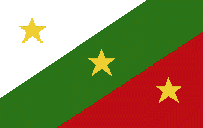
Mexican Flag of 1821
modern variant
|
The Flag of the Three Guarantees 1821-1824
This first Mexican tri-color flag was not a national flag, but rather a military one. It had a white, green, and red field that ran diagonally across the flag. In each field was a star. This flag is often referred to as "La Bandera de los Tres Garantias" or the Flag of the Three Guarantees. This flag was used from 1821 until 1824 by the military forces of Agustín I, who was deposed as Emperor of Mexico when the liberal Constitution of 1824 was implemented. ( For more detailed information about this flag - click here )
|
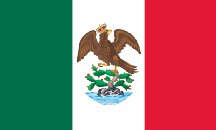
First Mexican National Flag
|
First Mexican National Flag 1821-1823
This flag was the First Mexican Flag to fly over the Mexican territories in Texas and California after the Mexican War of Independence ended Spanish rule. The First Mexican Empire was ruled by the revolutionary leader Agustín de Iturbide who was named emperor in 1821. The flag was a green-white-red vertical tricolor with a crowned eagle standing of a nopal raised out from a stone in the middle of the lake. The rule of Emperor Agustín I was short, and his government was replaced in 1823 with the First Mexican Republic.
|
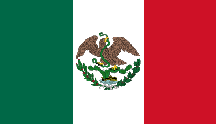
Second Mexican National Flag
|
The Second Mexican National Flag 1824
This second national flag was adopted around the same time as the establishment of the first federal republic in 1823. The only difference the new flag had was in the appearance of the central emblem. The crown was removed from the eagle's head and a serpent was placed in the eagle's right talon. Another addition to the flag is a branch of oak and laurel branches, a tradition which is carried over to the current flag. The Mexican flag has remained basically the same since 1824, except for changes made to the coat of arms.
To learn more about historical Mexican flags go to the "Historical Flags of Mexico" -
( Click here ).
|
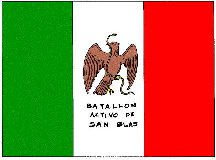
San Blas Battalion Flag
Battle of Chapultepec
|
The San Blas Active Coastguard Battalion Flag 1823
The San Blas Battalion was a Mexican infantry unit founded in 1823 in San Blas. It most famous action was in the Mexican-American War. The battalion participated in the Battle of Chapultepec, where it aided in the defense of Chapultepec Castle. Of the 300 men comprising the battalion, only a few survived the tragic battle against the American forces.
It was at this battle that six Mexican military cadets refused to fall back when General Bravo finally ordered retreat and instead fought to the death against the superior American forces. One by one they fell and when only cadet Juan Escutia was left, and the U.S. forces were about to kill him, he grabbed the Mexican flag, wrapped it around himself and jumped off the castle wall. It is said that the American commander saluted the body of Escutia wrapped in the Mexican flag. |
| Top of Page | Flags of Mexico |Flags of Early California | Flags of United States |
Six National Flags Over Texas
Six national flags have flown over Texas and are often flown together to commemorate their importance to Texan history. Between 1519-1685 Texas was under Spain, and then again between 1690-1821. Between 1685-1690 France ruled Texas. Between 1821-1836 the Mexican flag flew over Texas until Texas rebelled. Texas became the independent Republic of Texas between 1836-1845, but joined the United States in 1845 until the American Civil War when they opted to join the ill-fated Confederacy between 1861-1865. Since 1865 Texas has been a State in the United States of America. So these six flags have flown over Texas during its history.
|
|
|
Spain
1519-1690, 1690-1821 |
France
1685-1690 |
Mexico
1821-1836 |
|
|
|
Republic of Texas
1836-1845 |
Confederate States of America
1861-1865 |
United States of America
1845-1861, 1865-present |
Flags of Texas Independence

The Emerald Green Flag
|
First Republic of Texas Flag 1812-1813
In the fall of 1812, the Republican Army of the North, comprised of both revolutionaries and Americans under Bernardo Gutierrez and a former US Army Lieutenant named Augustus Magee, gained control of the Spanish province of "Tejas" and declared it the independent State of Texas. As first President of an independent Texas, Gutierrez established the first Constitution of Texas in 1813, but his government was clouded by the brutal execution of the captured Spanish Governor and several of his officers. Gutierrez was soon deposed by Colonel Alverez de Toledo, who renamed the movement the Republican Army of North Mexico, and was then defeated by the Spanish at the Battle of Medina in 1813, thus ending the short-lived First Republic of Texas. This solid emerald green flag was thought to have been introduced by Magee who was of Irish background. |
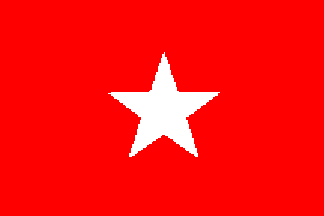
Long's 1st "Lone Star" Flag
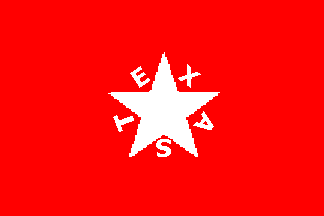
Long's 1st "Lone Star" Flag
(reported variant)

Long's 2nd "Lone Star" Flag
|
Second Texas Republic Flag - First and Second Invasions 1819-1821
This flag was displayed by the military expedition led by Dr. James Long in 1819 while Texas was still a province of New Spain. Long's expeditionary force was initially successful and captured the town of Nacogdoches where he declared the city to be the capitol of a new Republic of Texas.
He is said to have carried a solid red flag bearing a white five pointed star in the center, which would make it the first to display the "Lone Star" image. The flag was made by his wife, Jane Herbert Dent Wilkerson Long, according to the stories. Later, several newspapers articles, written in 1836, also described his red flag, but added letters spelling "Texas" placed between the points of the star.
Long's Republic only lasted one month, with Long being the first and only President, before the Mexican army ran him and his followers out of Texas. Long and his followers fled to New Orleans in Louisiana, where they began recruiting for a second invasion of Mexico.
While in New Orleans his wife made a second version of his flag adding 13 red and white stripes and placing the star in a red canton. It is considered by some to be the official flag of the second Texas Republic.
James Long and his followers once again invaded Texas in 1821 carrying their new Lone Star flag with its 13 red and white stripes, hoping their design would attract more Americans to their cause. Besides making the flags, his wife Jane Long, also became known as the "Mother of Texas" after she gave birth to a child on her husband's campaign against the Presidio La Bahia in Goliad.
Later, Long was invited to meet with those working for Mexican independence in Mexico City. When he arrived in Mexico City he was "accidentally" shot and killed under very suspicious circumstances. He is said to have been shot by a nervous soldier while removing his passport from his pocket. |
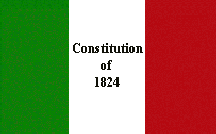
Dimmit's First Flag
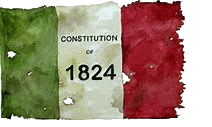
Dimmit's First Flag
PhotoShop image
|
Constitution of 1824 Flag
In 1835, Phillip Dimmit, a Kentuckian and local merchant, was placed charge of the captured Presidio La Bahía in Bexar, Texas. Dimmit at first was a strong voice for reconciling with Mexico and is credited for designing this flag that was destined to be carried at the Battle of the Nueces in November of 1835. He strongly felt that if the Mexican government followed the laws established in the Constitution of 1824 all would be well in Texas. Events soon proved him wrong.
Mexican forces had garrisoned nearby Fort Lipantitlán on the Nueces River and began operations against Bexar from this new position. In November of 1835, Dimmit, in response put together a force of about 30 mounted riflemen, under the command of Ira Westover, and sent them out to eliminate the threat. Although outnumbered, the Texans carried rifles, which outstripped the Mexican muskets for distance and accuracy. The Mexican Commander at Lipantitlán, Captain Nicolás Rodríguez, marched out to meet the approaching Texans with a force of 80 men, but was unable to find them. The Texans, avoiding the Mexican force, arrived at the small fort and the handful of Mexican troopers remained in the fort surrendered. When Rodríguez received word of the Texan capture of Lipantitlán, he rushed back and caught the Texans crossing the river after they had destroyed as much of the fort as possible. The "Battle of the Nueces" had begun.
The fight lasted about thirty-two minutes. Eight Mexican soldiers were killed with about twelve to fourteen wounded. First Sergeant Bracken was the only wounded among the Texans. Rodríguez refused to continue the fighting saying that the Texan rifle fire was more than his men could stand. The defeated Mexican force retreated toward Matamoros, while the Texans, after doing as much damage as possible to the fort at the Nueces, headed back toward the presidio at Bexar. Dimmit soon left Bexar and took command of the garrison at Goliad. |

Fredonian Rebellion Flag
|
Fredonian Rebellion Flag 1826
In May of 1822, President Monroe of the USA recognized the independent Republic of Mexico which had broken away from Spanish rule. Mexican policies soon led to unrest and rebellion. This flag was used by Hayden Edwards and his followers in East Texas in a rebellion against Mexican authorities in 1826. Edwards declared Texas independent and gave his land the name of "the Republic of Fredonia." He requested the United States government support his new "republic," but Congress refused. Without United States support, Edwards fled Texas. |
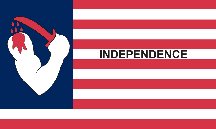
Brown's Flag
|
Brown's Flag of Independence 1835
This flag is said to have been designed by Capt. William S. Brown at Velasco in fall of 1835 and has been commonly confused with Capt. Dimmitt's bloody-arm flag (below) since it employs the same symbol.
Tradition tells us that this banner was flown by Brown and his men at the Battle of Bexar and then again at Goliad where Brown was a signer of the Goliad Declaration of Independence. Afterwards Brown also went to San Felipe where the banner was again said to be flown prior to his return home to Velasco. It also may have been flown in front of the American Hotel on Januery 8, 1836, along with the Troutman flag of the Georgia Battalion. |

Dimmit's Second Flag
|
Dimmit's Bloody Arm Flag 1835
This was the second flag designed by the Goliad garrison commander, Captain Philip Dimmit, and dramatically reflected his political shift away from support of statehood for Texas in the Mexican Federalist Republic to a complete separation from Mexico as an independent Republic (see the "Constitution of 1824 Flag" above). Phillip Dimmit was one of many Texans who changed their mind about reconciling with Mexico and by the time he left for Goliad in December of 1835, he was firmly for an independent Texas. He seems to have left his original conservative flag in Bexar along with his original beliefs so that by the time he arrived in Goliad he was using this white flag with a bloody arm holding a sword as his banner. This banner was used to celebrate the signing of an unsanctioned Declaration of Independence at Goliad on December 20, 1835. Unfortunately, time was running out for all those at Goliad. (See "Goliad Flag 1836" below) |
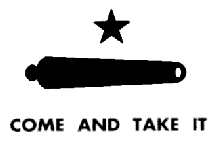
Come and Take It Flag
|
Gonzales Banner 1835
In September of 1835, Colonel Ugartechea, the commander of the Mexican garrison at San Antonio, sent a few unarmed men to the town of Gonzales to recover a cannon that had been loaned to the town to fight off occasional Indian attacks. The townspeople refused to give the cannon back and Colonel Ugartechea then sent some dragoons under Captain Francisco Castaneda to demand the cannon. As word of the disagreement spread, a Texan force of over 200 armed men arrived and the town was fortified. Two ladies of the town, Cynthia Burns and Evaline DeWitt, painted a flag on cotton cloth, depicting the cannon, the lone star of Texas, and the words "Come and Take It." As the small Mexican force approach Gonzales on October 2, the Texans formed their battle lines and after a brief battle, the outnumbered Mexicans withdrew, abandoning their supplies. Some Vexillologists (flag historians) believe the lone star was added at a later date, and not originally on the flag. |
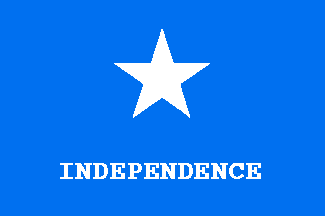
Scott Flag 1835
|
Scott's Flag of the Liberals 1835
Unlike the organized Mexican army, Texas forces were formed from a number of small groups, and Sam Houston and Stephen Austin often had trouble keeping these factions from starting a war with Mexico prematurely. One of these more radical groups wanting independence was formed in Lynchburg, Texas, by William Scott. Captain Scott commissioned an Italian immigrant to paint this design on a piece of blue silk. The company of 30 men were sent to join Colonel James Fannin's men. This flag was carried into the Battle of Concepción by James McGahey on October 28, 1835. |

The Dodson Flag
|
Washington on the Brazos/First Constitutional Convention Flag 1835
The first Constitutional Convention met at Washington on the Brazos in March of 1836, and flying over the hall was this flag designed and made by Sarah Dodson. She originally created it for her husband Archelaus Dodson, a member of the Robinson Company of the army volunteers formed at Harrisburg, Texas. After serving at Gonzales, this company marched under the Dodson flag to San Antonio to help capture the Alamo. The volunteers then returned to their homes after San Antonio had been taken from the Mexicans, not realizing that Santa Anna was marching toward Texas. After the Mexicans crushed the remaining forces at the Alamo and massacred the Texans at Goliad, the Robinson Company was assigned to protect retreating civilians. This exodus was known as the "Runaway Scrape." |
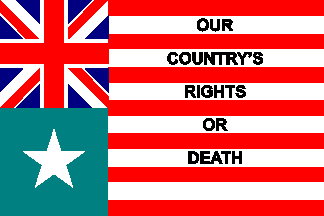
San Felipe Flag
|
San Felipe Flag 1836
In 1834, Captain Moseley Baker of Alabama came to Texas and joined the army raised by William Travis. This flag was made for him by Gail Borden in 1836.
The flag was given the name San Felipe in honor of the capital of Stephen Austin's Texas colony. Written on the White Stripes was the sentence "Our Country's Rights or Death" |

Troutman Flag 1836
Georgia Volunteer Battalion
|
Goliad Flag 1836
The Texan's fight for independence appealed to many people throughout the United States by 1835. Meetings were held and representatives of the new Texas government spoke in cities across the United States. Despite the official neutrality policy of the United States government, hundreds of volunteers headed to Texas to seek their fortunes.
This flag was made by 18-year old Johanna Troutman for the volunteer battalion, under the command of Colonel William A. Ward, sent to aid the Texas cause from Macon, Georgia. They came the aid of Colonel James Fannin and carried it at the disastrous Battle of Goliad in 1836. In the weeks that followed, virtually the entire Georgia company, the "Red Rovers" of Alabama, and the Texans including Fannin, a total of almost 390 men, were taken prisoner and massacred in Goliad after they lost the battles of Refugio and Coleto. |
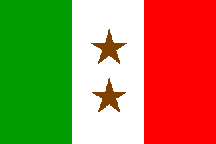
Texas-Coahuila Militia Flag
|
The Texas-Coahuila Militia Flag 1836
The 1824 Constitution of Mexico joined Texas with Coahuila to form the state of "Coahuila y Tejas." The new Mexican government had little money to devote to the military. Settlers were empowered to create their own militias to help control hostile Indian tribes. The Texas-Coahuila Militia was one such militia. In 1834, Colonel Jim Bowie was placed in command of Texas-Coahuila Militia. The flag used by Colonel Jim Bowie's group was a Mexican Merchant's Flag with two stars (either blue or brown), added on the white stripe. |

Alabama Red Rovers Guidon
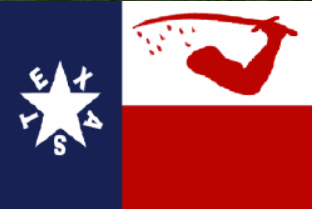
"Texian" Patriot Flag
(modern conglomeration)
|
The Alabama Red Rovers 1835-1836
The Alabama Red Rovers were a company of Alabamian volunteers organized in Courtland, Alabama, in 1835, under the command of Captain Jack Shackelford. About sixty volunteers signed up to help the Texans in their fight for independence from Mexico. The volunteer company uniforms consisted of caped hunting frocks and jeans made of a rusty red dyed linsey-woolsey, and they wore coonskin caps. The ladies of Courtland also presented the red clad soldiers with a simple red banner to serve as a company guidon.
The volunteers were stationed at Fort Defiance (the Texan´s name for Presidio LaBahia), a fort at Goliad. Soon after their arrival, the fort was surrounded by elements of the Mexican army led by General Jose Urrea. The fort commander ordered the evacuation of the Fort on March 19, 1836. However, the Mexican Army soon caught up with the retreating Texans in what would become the Battle of Coleto Creek. The next day the Texan's surrendered and were taken back to Presidio LaBahia and held as prisoners. On Palm Sunday, March 27, 1836, all of the prisoners that were well enough to travel were marched from the fort under false pretenses, and within a couple miles of the fort, they were halted and immediately massacred. Only Fifteen Red Rovers were able to escape the gruesome death of their comrades. Shackelford, who was in the infirmary at the time, also escaped the massacre. Captain Shackelford returned home to Courtland alone on July 9, 1836.
The Alabama Red Rovers, a modern Texan re-enactment club, uses a flag logo that is a conglomeration of several historical Texas flags. They call it the "Texian" Patriot Flag. It was designed by reenactor Josh Rieder. It combines the Dimmit, Alabama Red Rovers, DeZavala and the current Texas Flags. |
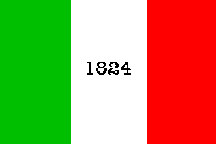
Traditional Alamo Flag
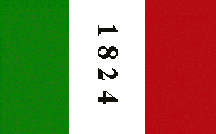
McArdle's Final Design

McArdle's First Design
|
The Alamo Flag 1836
This flag, also known as the flag of Texas Conservatives because it was used by those conservative Texans who wished for peace with Mexico, is traditionally presented as the flag that flew over the Alamo when Santa Anna's army attacked the fortified mission in 1836, although there is no real evidence to prove that this was the flag used that day at the Alamo. The actual flag was not captured and preserved by the victors nor recorded in the military accounts of the day. But often tradition replaces fact.
As in all cases like this, there are different possibilities in the design of the flag. One version of the "Alamo Flag", is used by Artist H. A. McArdle who shows the numerals written vertically on the white bar. McArdle did extensive research into all details of the era before painting "Dawn at the Alamo", which now hangs in the Texas Legislature. He actually did two versions of the painting and on the earliest one he painted the numerals horizontally in gold.
Whatever version of the flag used at the battle, the three day Battle of the Alamo became legendary in Texas and American history. On March 6, 1836, on the final day, the Mexicans attacked before dawn, and all 188 defenders of the Alamo perished. After the Battle, General Santa Anna asked to see the corpses of Bowie, Travis, and Crockett, and Bexar Mayor Francisco Ruiz identified the bodies for him. Their names became immortal in the annals of Texas history. The cry of "Remember the Alamo" became the battle cry of the Texas army and eventually led to Santa Anna's ultimate defeat and Texas independence
The only actual flag to survive the battle was a company flag, that of the New Orleans Grays. It represented a small group of defenders who fought and died on a section of the wall. It was hauled down by a Mexican officer and later presented to Santa Anna, who sent it back to Mexico City with his dispatches. It is now on display at the Mexican National Museum of History in Mexico City. (see below) |
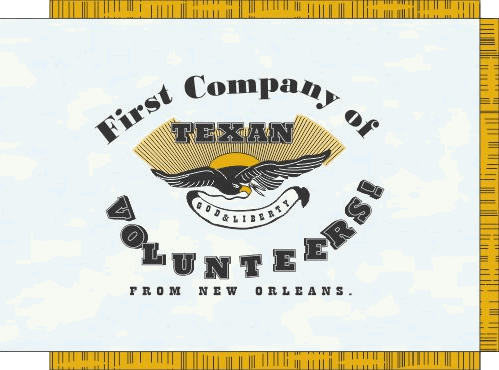
New Orleans Grays
1st Company
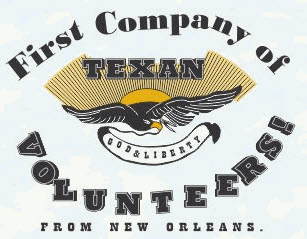
Shield Detail
|
First Company of the New Orleans Grays 1836
The New Orleans Grays consisted of two volunteer militia companies formed in New Orleans for service in the Texas War of Independence. Their name came from the gray military fatigues they wore, because unlike the majority of the volunteers, the Grays looked like soldiers and had uniforms and some semblance of military discipline. The Grays were present at most of the major battles of the war. Their flag featured an eagle with outstretched wings, holding a banner in its beak, with the words "God & Liberty" written on it.
Although the 1st Company Flag was never meant to be a flag that represented all the defenders of the Alamo, it is, at present, the only existing and documented Texan flag from the battle. Based on comments from both sides this flag flew during the siege and final storming of the Alamo. It was hauled down by a Mexican officer as his troops captured the portion of the mission wall where the flag flew.
The flag was presented to Santa Anna after the battle, and was sent back to Mexico City along with his dispatches about the battle. His note accompanying the flag commented "The bearer takes with him one of the flags of the enemy's battalion captured today. The inspection of it will show plainly the true intention of the treacherous colonists and of their abettors who come from parts of the United States of the North." Today, the flag is kept as a war trophy from the Texas Rebellion at the Mexican National Museum of History located at Chapultepec Palace in Mexico City.
|
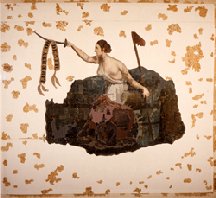
San Jacinto Flag
|
The Newport Rifles Flag 1836
This was the banner the Texans carried at the turning point of their War for Independence. Santa Anna's army of over 6,000 men had swept across Texas to the grassy plains of San Jacinto. It appeared all was lost, but a sudden morning surprise attack at San Jacinto by the Texas army under the command of Sam Houston changed everything and in less than 20 minutes it was all over. With cries of "Remember the Alamo" and "Remember Goliad," they had charged into the Mexican camp, Santa Anna was captured, and the war was over.
The flag is believed to have been painted by artist James Henry Beard in late 1835 as a gift for the Newport Rifles, a 52-man company of Kentucky volunteers led by Captain Sidney Sherman. The rifle company was formed to help Texans battle the Mexican Army. Their flag was the only one carried at the Battle of San Jacking. |

Lorenzo de Zavala Flag
(Fictitious Design)
|
Republic of Texas First National Flag (unknown) 1836
According to legend, the second thing that the First Constitutional Convention had done after declaring Texas independent, writing a new constitution, and electing the first leaders, was to selected and approve a design for a new flag in 1836. They chose a design by Lorenzo de Zavala, the most accomplished statesman among the delegates. Zavala, a native of Spain, had served as Mexico's Secretary of the Treasury, Minister to Paris and as President of the Constitutional Congress in 1824 before siding with the Texans.
Although the story is true, there is no surviving record that a flag design was actually adopted, and it's anyone's guess what the flag would have looked like since no one knows what design Zavala actually proposed.
The fictitious "Lorenzo de Zavala" flag that one sees in flag books (shown here) comes from a 1930s era book entitled "The Romantic Flags of Texas" written by Mamie Wynne Cox, a member of the Daughters of the Republic of Texas. In her book Cox provided this fictitious flag design, although obviously based on Long's flag of 1819.
|
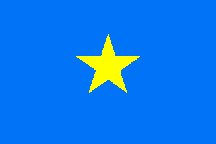
Burnet Flag
|
Republic of Texas First National Flag 1836-1839
In December of 1836, the new government of Texas met at Columbia and the First Congress accepted the suggestion of David Burnet to recognize a new design for the "National Flag" of Texas. David Burnet was the first provisional President of the Texas Republic, and he actually designed this flag himself.
Records indicate that little regard was given to the previous Zavala design suggestion of eight months earlier. The Burnet flag in turn was replaced in 1839 by the final national flag. |
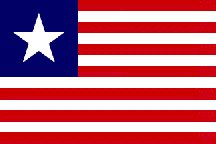
Texas Naval Ensign
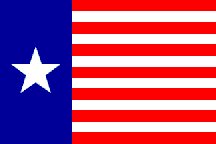
Texas Naval Ensign
(Questionable variant)
|
Flag of the Texas Navy 1836-1846
If the Mexicans had controlled the Gulf of Mexico and blockaded Texas, it is unlikely that Texas could have won their independence. In November of 1835, the Texas Navy was formed with four ships named the Independence, Brutus, Liberty and Invincible.
At first these ships flew the Alamo flag, but in 1836 this new design created by Charles Hawkins, the first Commodore of the Texas Navy, replaced it as the Naval Ensign. The Texas Navy was able to successfully protect the Texas coast. By 1839, the growing fleet had 10 vessels that were putting enormous pressure on Mexico by seizing Mexican ships and their cargoes, attacking Mexican coastal cities, and stopping foreign ships headed for Mexico. To this very day, the Texas Navy's victory over superior Mexican forces at Campeche in 1843 is the only time sailing ships ever defeated steam-powered craft in a major sea battle.
The second version of the Texan Naval Ensign shown here was found on several 19th century flag sheets, but no documentary evidence has been found yet in the Texas archives to indicate it actually existed. It appears to be a composite design of the Lone Star Republic Flag of 1939 and the Texas Naval Ensign of 1836. |

Lone Star Republic Flag
|
Republic of Texas Second National Flag 1839-1846
State of Texas Flag 1846-present
Meeting in Houston in January of 1839, the Third Congress of the Republic of Texas approved a new flag design by Charles Stewart, the second man to sign the Declaration of Independence. This flag was the national flag of Texas until 1846, when Texas became the 38th state of the Union, and this flag became their state flag instead. Texas has the distinction of being the only state that was ever a sovereign independent nation, recognized by the United States, Great Britain and other major European powers of the day. The Texas State Flag is, of course, the only state flag that was once an independent national flag. |
| Top of Page | Historical Flags of Mexico | Flags of Texas Independence | Flags of Early California |
Period Flags of the United States
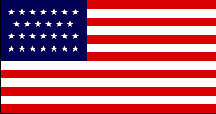
27-Star USA Flag
|
The 27-Star United States of America Flag 1845-1846
Just prior to the start of the Mexican-American War the National flag had 27 states and 27 stars. This would change with the admission of Texas.
It should be noted here that Congress had never made any regulation about what type of star pattern should be used on the "official" United States flag. Therefore, any pattern was acceptable. |
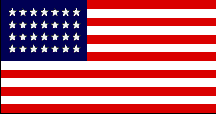
28-Star USA Flag
|
The 28-Star United States of America Flag 1846-1847
With the admission of Texas as the 28th state in the Union, the flag star pattern was changed.
The Navy regulated the star pattern on their "boat" flags to horizontal rows, but the Army and civil government did not. Therefore, there could be many different star patterns, those shown in this section are the most conservative. |
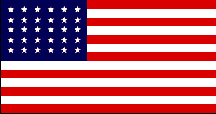
30-Star USA Flag
|
The 30-Star United States of America Flag 1848-1851
With the additions of Iowa in 1847 and Wisconsin in 1848 into the Union, the flag star pattern was changed to this.
During the time that this flag was official, the Treaty of Guadalupe Hidalgo ended the Mexican-American War, Zachary Taylor became President, the California Gold Rush began, President Taylor threaten to veto the proposed Compromise of 1850 even if it meant a Civil War, Taylor died and Millard Fillmore became the President and the Compromise of 1850 passed, and finally, California became the 31st State.
|
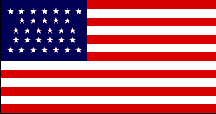
31-Star USA Flag
|
The 31-Star United States of America Flag 1851-1858
In 1851, the Golden State of California was added to the Union by the Compromise of 1850 and once again the flag star pattern was changed.
During the troubled time that this flag was official, Franklin Pierce became President, Commodore Matthew Perry openned Japan, the Gadsden Purchase added a possiable southern route for a transcontinental railroad, the Kansas-Nebraska Act nullified the Missouri Compromise, Penn State University was founded, The City of Lawrence in Kansas was sacked, the Pottawatomie Massacre took place, James Buchanan became President, Dred Scott v. Sandford in the Supreme Court declared that blacks were not citizens of the United States, the Utah War began, the LeCompton Constitution was rejected in the Kansas Territory, the Transatlantic cable was laid, the Lincoln-Douglas Debates took place, and the Civil War loomed.
|
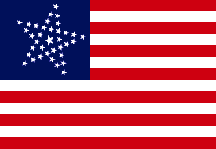
31-Star "Great Star" Design
|
The 31-Star Great Star Flag 1851-1858
This design was a very poplar one with the general public, but was not made official in 1851. The military never used this flag design. |
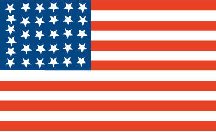
31-Star USA Naval Flag
|
Commodore Matthew Perry's Flag 1853
The story of this 31-star flag begins in 1853 when Commodore Matthew Perry and his U.S. Navy squadron forced the opening of Japan to the West by sailing into Tokyo Harbor with his "black" fleet of modern warships. His success lead to formal diplomatic ties, access of ports by American ships, aid for shipwrecked American sailors, commercial trade and the opening of Japan to other Western nations. The Japanese military forces could not resist Perry's modern weaponry and were forced to sign the Convention of Kanagawa in 1854. In Japan the term "Black Ships," came to symbolize a threat imposed by Western technology.
The flag's design has a "less than perfect" star pattern common in 19th century flags when there were no standard designs; they stuffed an extra star into the first column.
|
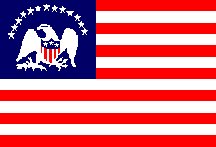
Presentation Standard 1804
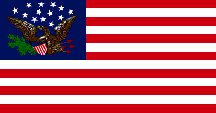
13 Star Eagle Standard 1824
|
Indian Department Eagle Presentation Flags 1803-c1862
If an Indian tribe showed willingness to come under the "protection" of the United States they would sometimes be presented with a special version of the United States flag by the Indian Department. These presentation flags usually had eagles and thirteen stars in their cantons.
This practice began with the Lewis and Clark expedition when they presented one such flag to the chief of the Mandan Indians and another to the chief of the Teton Indians in 1804. Andrew Jackson presented another presentation flag to the Chippewa Chief Sheeboy-way in 1809. This practice continued throughout the early 19th Century. |
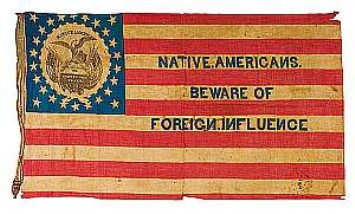
"Know Nothing" Party Flag
(American Party after 1855)
|
Native American Party 1841-1856
The Native American Party, also called the "Know Nothings," was founded in 1841 at a state convention in Louisiana. It is an early example of the bigotry practiced just prior to the Civil War, both in the North and the South. Its general tenets were based on the philosophy that foreigners (and especially Irish Catholics) were a danger to the American society. Party members adhered to the belief that foreigners should not be allowed to hold any office of public trust in the government. In 1854, the party supported a policy that United States citizenship should be granted only after an emigrant had lived in this country for 21 years.
The name "Know Nothing" came from the practice of the members of this semi-secret organization of answering all questions with "I know nothing." Mainly active from 1854 to 1856, it strove to curb immigration and naturalization, though its efforts met with little success. There were few prominent leaders, and the largely middle-class and entirely Protestant membership fragmented over the issue of slavery. In 1855, it renamed itself the American Party. |
| Top of Page | Historical Flags of Mexico | Flags of Texas | Flags of Early California | Flags of United States |
|